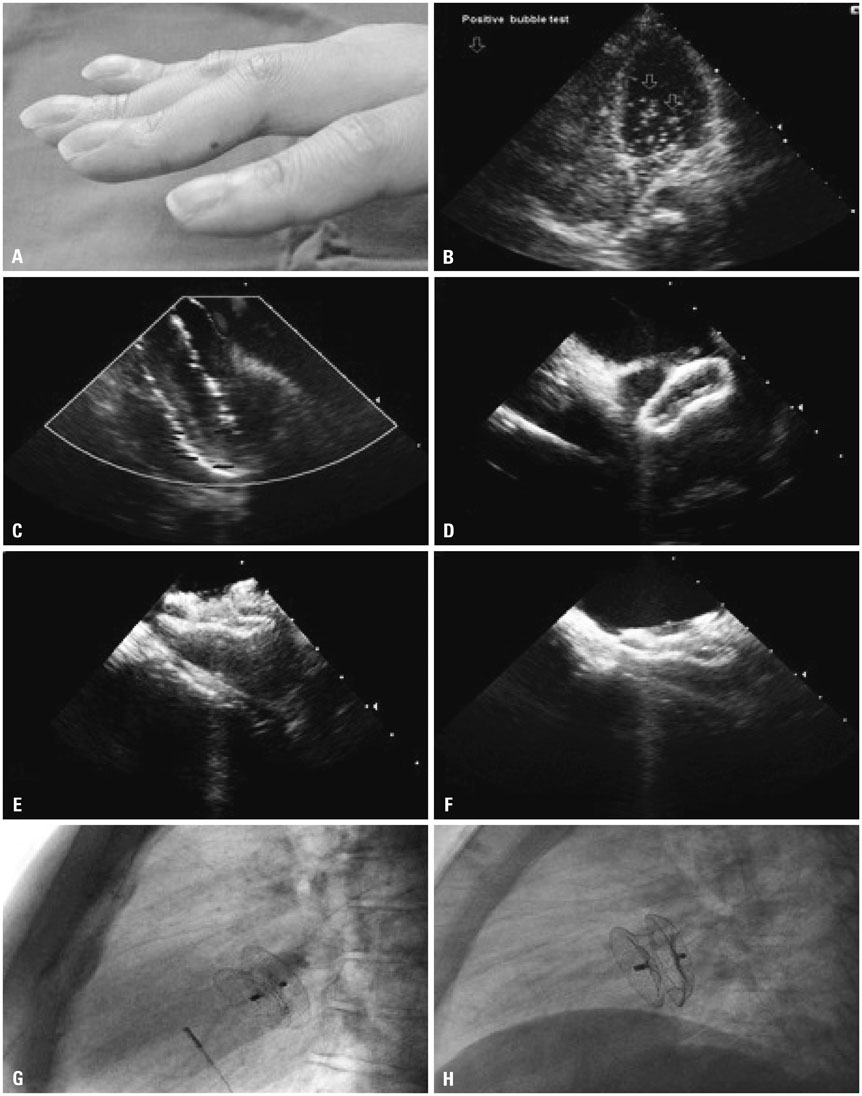Yonsei Med J.
2016 May;57(3):799-802. 10.3349/ymj.2016.57.3.799.
Platypnea-Orthodeoxia Syndrome Two Decades after Definitive Surgical Repair of Pulmonary Atresia with Intact Ventricular Septum
- Affiliations
-
- 1Department of Pediatrics, Division of Pediatric Cardiology, Changhua Christian Children's Hospital, Changhua, Taiwan. ferdielee@yahoo.com
- 2Department of Surgery, Division of Cardiovascular Surgery, Changhua Christian Children's Hospital, Changhua, Taiwan.
- 3Department of Surgery, Division of Cardiovascular Surgery, College of Medicine, National Taiwan University Hospital, Taipei, Taiwan.
- KMID: 2374105
- DOI: http://doi.org/10.3349/ymj.2016.57.3.799
Abstract
- A 20-year-old female had undergone definitive surgical repair for pulmonary atresia with intact ventricular septum soon after birth. She was referred to our institution with the chief complaint of clubbing fingers. A thorough examination revealed platypnea-orthodeoxia syndrome due to an interatrial right-to-left shunt through a secundum atrial septal defect. Percutaneous closure with an Amplatzer Septal Occluder resulted in resolution of the syndrome.
Keyword
MeSH Terms
Figure
Reference
-
1. Cheng TO. Platypnea-orthodeoxia syndrome: etiology, differential diagnosis, and management. Catheter Cardiovasc Interv. 1999; 47:64–66.
Article2. Akin E, Krüger U, Braun P, Stroh E, Janicke I, Rezwanian R, et al. The platypnea-orthodeoxia syndrome. Eur Rev Med Pharmacol Sci. 2014; 18:2599–2604.3. Suzuki H, Ohuchi H, Hiraumi Y, Yasuda K, Echigo S. Effects of postural change on oxygen saturation and respiration in patients after the Fontan operation: platypnea and orthodeoxia. Int J Cardiol. 2006; 106:211–217.
Article4. Blanche C, Noble S, Roffi M, Testuz A, Müller H, Meyer P, et al. Platypnea-orthodeoxia syndrome in the elderly treated by percutaneous patent foramen ovale closure: a case series and literature review. Eur J Intern Med. 2013; 24:813–817.
Article5. Eicher JC, Bonniaud P, Baudouin N, Petit A, Bertaux G, Donal E, et al. Hypoxaemia associated with an enlarged aortic root: a new syndrome? Heart. 2005; 91:1030–1035.
Article6. Shakur R, Ryding A, Timperley J, Becher H, Leeson P. Late emergence of platypnea orthodeoxia: Chiari network and atrial septal hypertrophy demonstrated with transoesophageal echocardiography. Eur J Echocardiogr. 2008; 9:694–696.
Article7. Knapper JT, Schultz J, Das G, Sperling LS. Cardiac platypnea-orthodeoxia syndrome: an often unrecognized malady. Clin Cardiol. 2014; 37:645–649.
Article
- Full Text Links
- Actions
-
Cited
- CITED
-
- Close
- Share
- Similar articles
-
- Percutaneous Pulmonary Balloon Valvotomy and PDA Stent Insertion for Pulmonary Atresia with Intact Ventricular Septum
- Pulmonary atresia with intact ventricular septum
- Surgical treatment of pulmonary atresia with intact ventricular septum without extracorporeal circulation: report of one case
- Mid-term Results of Neonatal Surgical Management of Pulmonary Atresia with Intact Ventricular Septum
- Two Cases of Congenital Pulmonary Atresia with Intact Ventricular Septum in Brother


